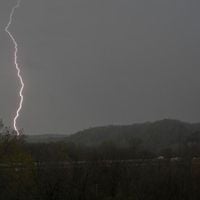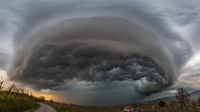Germany is bracing for a dramatic shift in weather as Holy Week unfolds, with temperatures swinging wildly and storms on the horizon. According to meteorologist Dominik Jung from wetter.net, the nation is set to experience an "extraordinary and unprecedented weather situation for the first half of April." As the week progresses, temperatures are expected to soar to nearly 30 degrees Celsius in some areas, a stark contrast to the typical spring weather.
Starting Monday, April 14, 2025, temperatures across Germany could approach the summer-like mark, with a deviation of more than ten degrees above the long-term average. This sudden warmth is attributed to a massive southwest flow bringing warm and humid air from North Africa and the western Mediterranean. Jung noted, "We are experiencing a temperature deviation of more than ten degrees above the long-term average. This is quite unusual for this time of year." However, this heat is accompanied by the threat of severe thunderstorms.
From mid-week, meteorologists anticipate the arrival of strong thunderstorm cells, particularly in western and southern Germany. These storms could bring heavy rainfall, hail, and strong gusts of wind. The German Weather Service (DWD) has warned that the strongest thunderstorms are expected on Wednesday, April 16, 2025, particularly in the triangle between Frankfurt am Main, Erfurt, and Hamburg. As the storms roll through, they are expected to last into the late evening, moving from south to north.
In terms of precipitation, the Black Forest region could see up to 60 liters of rain per square meter by Easter Monday, April 21, 2025. Most other areas will receive between 20 and 40 liters, while regions between Meppen and Aachen, and between Leipzig and Schwerin, are expected to remain relatively dry. However, the weather forecast is still uncertain for the weekend, as heavy rain from Upper Italy could potentially reach Germany.
As Easter approaches, the weather pattern is becoming increasingly unpredictable. Easter Sunday, April 20, 2025, may bring continuous rain at the edge of the Alps, while Easter Monday could see severe and continuous rainfall stretching from Saxony to Mecklenburg-Vorpommern. Additionally, light snowfall is possible in the Alps and the Allgäu region, particularly above 900 meters, although any snow that falls at lower altitudes is unlikely to accumulate.
In North Rhine-Westphalia, the weather is also set to take a turn for the worse. A low-pressure area will bring storms and rain showers, with forecasts indicating up to 40 liters of rain in some areas. Starting Tuesday, April 15, 2025, temperatures are expected to drop significantly, falling from 23 degrees Celsius in the afternoon to just 7 degrees overnight. This change will coincide with the arrival of showers and thunderstorms, which are expected to continue into the night and throughout the week.
Weather models suggest that from Wednesday to Friday, the heaviest rainfall in North Rhine-Westphalia will occur, with predictions of more than ten liters of rain per square meter per day. The ICON weather model anticipates that Cologne and its surroundings will experience the strongest rainfall, with estimates ranging from 20 to 40 liters per square meter. However, there is still some uncertainty regarding the exact amount of rain, as different models provide varying forecasts.
Interestingly, this drastic weather shift comes after North Rhine-Westphalia experienced its driest March in almost a century. The region's agricultural sector is in dire need of rain to combat the effects of drought, and environmentalists hope that the impending storms will reduce the risk of wildfires, which have recently plagued the area.
As the week draws to a close, the weather situation remains fluid, with meteorologists keeping a close eye on developments. The sudden transition from mild spring days to summer-like conditions, followed by severe thunderstorms, has taken many by surprise. It raises questions about the impact of climate change on weather patterns, as climatologists point to such extreme spring-summer situations as indicative of a broader weather shift.
In summary, the upcoming days in Germany are set to be marked by significant temperature fluctuations, storms, and rainfall. With Holy Week traditionally seen as a time for family gatherings and outdoor activities, many will be left wondering whether they'll be celebrating Easter in the sunshine or seeking shelter from the storms.







